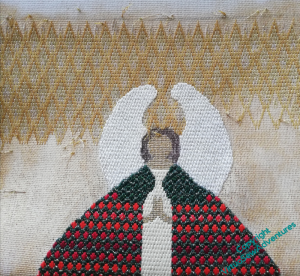Tag: embroidery for interior decoration
Another footstool

Remember this footstool?
It has a cousin, also worked by Grandmama, which has been working hard as the footrest at my mother’s computer desk, and the stitching of which is past recovery.
So the idea is that I should do a canvaswork panel for it, and Only From Stash. After all, where is the point of having a stash if you don’t make good use of it?

That is all very well – I do have some suitable canvas. Just!
But much of my tapestry wool stash is inherited from others – notice the huge pile of neutrals! – and it might be rather a wild ride to get a 10 x 21 inch piece of sensible 10 count canvaswork out of this selection.
I had intended to do something with Clarice Cliff colours, but as it happens, I don’t have as much leftover of those colours as I thought I had. I’m pretty sure that the pinks won’t figure, and unfortunately the greens are too thin on the ground and too mismatched, as well. Much thought will be needed!
While I was thinking about that, however, I also prepared Episode 35, the first SlowTVStitchery video for the new project, the Canvaswork Angel, in which the Christmas Angel is introduced, and there is some discussion of the detrimental consequences of visual confusion and the delaying effect of Doubts.
A little box to embellish
I can’t remember where I got this little box – probably eBay – but it was so long ago, I don’t remember what I had in mind, if anything. It’s about five inches by two inches.
I found it again, and decided it was about time I came up with something to do with it.
This is a bit of carved stonework I photographed in Lisbon. I should warn you that the finished piece is probably going to be really very unlike this inspiration, because, if you look at the rough ideas below, you will see it is already wandering. And when I started thinking about it, it was going to be surface embroidery, and now I’m thinking about silk purl and wire purl.
I think the ribbon things are going to change somewhat as well, although I’m not sure quite how..
In other news, Episode 33 of Slow TV Stitchery is now live, in which the penultimate corner is completed, and the contents of Autumn’s book stash is discussed.
More on the cover for the magnifier
The embroidery on the new cover for Maggie The Magnifier is relatively simple, but it does involve a few favourite stitches.
First and foremost, Braid Stitch. Not the Infamous Plaited Braid Stitch – I was sure I wouldn’t have enough wool for that! – but the ordinary Braid Stitch. I’ve been fond of it for years, as it makes a good, strongly textured line, and it’s much easier than it looks. It’s also fairly easy to work in the hand, and this was very much a holiday period project, using bits and pieces I could easily get hold of, which didn’t include my embroidery hoops!
The central rosette uses satin stitch (not a favourite, exactly, but very effective!), Romanian Stitch, and in the centre, a little knotted stitch that I’m sure I know from a book, and has a name, but it just came swimming up out of my head, unattributed, as though I was making it up as I went along.
The buds, or finials, or whatever they are, are in nested fly stitches, outlined with further fly stitches, and you will note, from this view, that I stuck to my decision to draft the design by hand, and not tweak and even it up. This is very much a piece of domestic, informal embroidery, and there’s no reason for it to look glossy and machine made.
Cover for my new magnifier
Meet Maggie the Magnifier, so called to distinguish her from Jenny the Jensen Magnifier Light. Maggie was a Christmas present from my cousin. She’s wonderfully sturdy, with a nice heavy base, and notwithstanding the base mentions 1815, we think that was the foundation of the company, and Maggie herself is probably from the 1920s. She will be very useful for details and work at the table, rather than at my embroidery frame, but she needs a cover, both to keep the dust off, and to stop her setting fire to things on those rare occasions when the sun comes out.
Making the cover seemed a good way to pass the time over the period when I had Akhenaten hidden away, so I used a piece of brushed bouclé fabric and some rather lovely wool thread I got from somewhere-but-I-can’t-remember-where.
Since I did the Great Lady’s Magazine Stitch Off, I’ve become very conscious of what I learnt that I didn’t anticipate – becoming aware of how much more often an embroiderer of that period would have reckoned that Close Enough Is Good Enough, how often a pattern would have been sketched on by eye, rather than prick-&-pounced for precision, how much effect and speed would have trumped detail. I’m trying to apply that myself – when I don’t need exactitude, I don’t intend to strive for it. I hope it will make fun new projects more fun, and more “free”. This is a perfect candidate for that approach.
The basis of the design is a floral pattern from a rather gorgeous book called “Pattern and Ornament in the Arts of India”, with curlicues in the corners of the square of fabric. I practiced a couple of times in a notebook, and then simply drew the design in chalk on the fabric and started stitching.
This is going to be one of my New projects for this year…



















